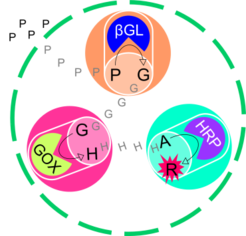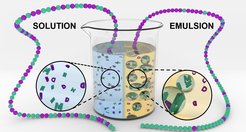
Research of the Landfester Group
Nanocontainers

Metabolic reactions in confined spaces are key phenomena in living organism. Inspired from the features, we have developed polymer-based nanocontainers that behave catalytic reactions as building blocks for synthetic cells. We are interested in the mimicking tasks with enzymatic metabolisms, energy regeneration and useful production, ultimately toward replacement of part of life-systems and applications in biological or environmental purposes. Now our achievements are designing silica nanocontainers with loaded enzymes as modules. These enable enzymatic cascade reactions between subcompartments in confinements, coenzymes regeneration to mimic mitochondrial metabolisms and controlling reactive oxygen species for autoxidation effects and therapeutics.
Polymersomes

The bottom-up approach in synthetic biology involves the engineering of synthetic cells by designing biological and chemical building blocks, which can be combined in order to mimic cellular functions. The first step for mimicking a living cell is the design of an appropriate compartment featuring a multifunctional membrane. This is of particular interest since it allows for the selective attachment of different groups or molecules to the membrane. In this context, we report on a modular approach for polymeric vesicles, so-called polymersomes, with a multifunctional surface, namely hydroxyl, alkyne and acrylate groups. We demonstrate that the surface of the polymersome can be functionalized to facilitate imaging, via fluorescent dyes, or to improve the specific adhesion to surfaces by using a biotin functionalization. This generally applicable multifunctionality allows for the covalent integration of various molecules in the membrane of a synthetic cell. Additionally, we are also exploring ways to induce growth in polymersomes by delivering amphiphilic building blocks that can fuse with the membrane and increase its surface area. Polymersomes that grow under stimulation could be used to implement complex cell behavior in synthetic systems.
Photobiocatalysis
In cells, complex chemical transformations can be viewed as the result of a large number of concerted interactions between functional modules, each responsible for different tasks required for the survival of the cell. This idea has inspired us to design functional modules that can perform simple biomimetic transformations using light as the trigger. Our functional modules are created by encapsulating nanoparticle photocatalysts (NPs) in synthetic compartments made of amphiphilic polymer (polymersomes). Using this strategy, we have developed a functional module that regenerates nicotinamide adenine nucleotide coenzymes (NAD) upon light irradiation. [Ma et al. ChemBioChem 2019]. The advantage of using NPs is that different functional modules can be obtained through the choice of the NPs or by combining different NPs. This opens the possibility for the creation of a library of modules that could be used together to achieve cell like behavior.
Compartmentalization to Control Copolymerizations
Sturdy molecular chains called gradient polymers have long proved difficult to synthesize. Using compartmentalization is a simple way to make them. In a gradient polymer, the composition gradually transitions along the polymer’s length, from mostly one component to mostly another.

Making gradient polymers is a laborious task and often needs special dosing techniques. Nature can make multi-segmented copolymers within living cells. We sequestered two types of monomers in an emulsion, in which droplets of one monomer are dispersed throughout the second monomer. By exploiting the monomers’ different solubility, we were able to confine the polymerization inside of nano-droplets of the emulsion. As that compound was gradually consumed, the change in concentration pulled ever-greater amounts of the other ingredient into the chains, creating a gradient effect [Rieger et al. Angew.Chem. Int. Ed. 2018].


